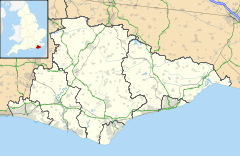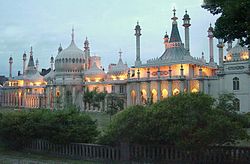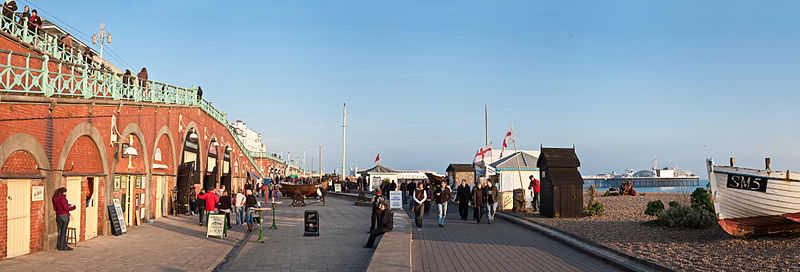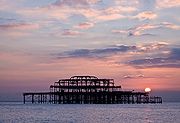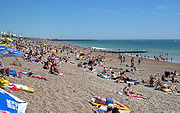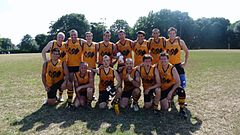
Brighton
Did you know...
Arranging a Wikipedia selection for schools in the developing world without internet was an initiative by SOS Children. SOS Children has looked after children in Africa for forty years. Can you help their work in Africa?
Coordinates: 50.842941°N 0.1313120°W
| Brighton | |
|
From upper left: Brighton Dome, Royal Pavilion, Town Hall, The Lanes and Brighton Pier. |
|
|
|
|
| Population | 155,919 |
|---|---|
| Demonym | Brightonian |
| OS grid reference | TQ315065 |
| Unitary authority | Brighton and Hove |
| Ceremonial county | East Sussex |
| Region | South East |
| Country | England |
| Sovereign state | United Kingdom |
| Post town | BRIGHTON |
| Postcode district | BN1, BN2, BN50, BN88 |
| Dialling code | 01273 |
| Police | Sussex |
| Fire | East Sussex |
| Ambulance | South East Coast |
| EU Parliament | South East England |
| UK Parliament | Brighton Kemptown |
| Brighton Pavilion | |
|
|
Brighton (pronounced /ˈbraɪtən/) is the major part of the city of Brighton and Hove (formed from the previous towns of Brighton, Hove, Portslade and several other villages) in East Sussex on the south coast of Great Britain. For administrative purposes, Brighton and Hove is not part of the non-metropolitan county of East Sussex, but remains part of the ceremonial county of East Sussex, within the historic County of Sussex.
The ancient settlement of Brighthelmstone dates from before Domesday Book (1086), but it emerged as a health resort featuring sea bathing during the 18th century and became a destination for day-trippers from London after the arrival of the railway in 1841. Brighton experienced rapid population growth, reaching a peak of over 160,000 by 1961. Modern Brighton forms part of the Brighton/Worthing/Littlehampton conurbation stretching along the coast, with a population of around 480,000.
Brighton has long been renowned throughout the UK and Europe as gay-friendly, and is home to a large LGBT community. Eight million tourists a year visit Brighton. The city has a substantial business conference industry regularly hosting the Liberal Democrats, Labour Party, Conservative Party and Trade Union annual conferences. Brighton has two universities and a medical school.
History
In the Domesday Book, Brighton was called Bristelmestune and a rent of 4,000 herring was established. In June 1514 Brighthelmstone was burnt to the ground by French raiders during a war between England and France. Only part of the St Nicholas Church and the street pattern of the area now known as " The Lanes" survived. The first drawing of Brighthelmstone was made in 1545 and depicts what is believed to be the raid of 1514. During the 1740s and 1750s, Dr Richard Russell of Lewes began prescribing seawater at Brighton.
By 1780, development of the Georgian terraces had started and the fishing village became the fashionable resort of Brighton. Growth of the town was further encouraged by the patronage of the Prince Regent (later King George IV) after his first visit in 1783. He spent much of his leisure time in the town and constructed the Royal Pavilion during the early part of his Regency. Although contracted forms of the name are attested since the 15th Century, it was not until this period that the modern form of the name came into common use.
The arrival of the railway in 1841 brought Brighton within the reach of day-trippers from London and population growth from around 7,000 in 1801 to over 120,000 by 1901. The Victorian era saw the building of many major attractions including the Grand Hotel (1864), the West Pier (1866) and the Palace Pier (1899). Prior to either of these structures the famous Chain Pier was built, to the designs of Captain Samuel Brown. It lasted from 1823 to 1896, and featured in paintings by both Turner and Constable.
After boundary changes between 1873 and 1952, the land area of Brighton increased from 1,640 acres (7 km2) in 1854 to 14,347 acres (58 km2) in 1952. New housing estates were established in the acquired areas including Moulsecoomb, Bevendean, Coldean and Whitehawk. The major expansion of 1928 also incorporated the villages of Patcham, Ovingdean and Rottingdean, and much council housing was built in parts of Woodingdean after the Second World War.
More recently, gentrification of much of Brighton has seen a return of the fashionable image which characterised the growth of the Regency period. Recent housing in the North Laine, for instance, has been designed in keeping with the area.
In 1997 Brighton and Hove were joined to form the unitary authority of Brighton and Hove, which was granted city status by Queen Elizabeth II as part of the millennium celebrations in 2000.
Brighton is sometimes referred to as London-by-the-sea.
Landmarks
The Royal Pavilion is a former royal palace built as a home for the Prince Regent during the early 19th century, under the direction of the architect John Nash, and is notable for its Indo-Saracenic architecture and Oriental interior. Other Indo-Saracenic buildings in Brighton include the Sassoon Mausoleum, now, with the bodies reburied elsewhere, in use as a chic supper club.
Brighton Marine Palace and Pier ( long known as the Palace Pier) opened in 1899. It features a funfair, restaurants and arcade halls.
The West Pier was built in 1866 and has been closed since 1975 awaiting renovation, which faces continual setbacks, The West Pier is one of only two Grade I listed piers in the United Kingdom, but suffered two fires in 2003. Plans for a new landmark in its place – the i360, a 183 m (600 ft) observation tower designed by London Eye architects Marks Barfield – were announced in June 2006. Plans were approved by the council on 11 October 2006. As of early 2009, construction had yet to begin, but the area has been cordoned off.
Created in 1883, Volk's Electric Railway runs along the inland edge of the beach from Brighton Pier to Black Rock and Brighton Marina. It is the world's oldest operating electric railway.
The Grand Hotel was built in 1864 and the scene of the 1984 Brighton Hotel Bombing. Its nighttime blue lighting is particularly prominent along the foreshore.
Churches and places of worship
The 11th century St Nicholas Church is the oldest building in Brighton, commonly known as "The Mother Church". Other notable churches include the large brick-built St Bartholomew's, and St Peter's in the heart of Brighton on an island between the Lewes Road and the London Road.
There are four synagogues in the Brighton area, including the Brighton & Hove Progressive Synagogue (Liberal) at 6 Landsdowne Road in Hove; Brighton and Hove Hebrew Congregation at 66 Middle Street in Brighton (Orthodox), Hove Hebrew Congregation at 79 Holland Road in Hove (Orthodox) and Brighton & Hove Reform Synagogue on Palmeira Avenue in Hove (Reformed). Middle Street Synagogue, Brighton is an important Grade II listed building built in 1874–75, and one of the most beautiful small synagogues in Europe. It is presently in the process of being gradually restored by English Heritage. About 12% of the population of the Brighton & Hove conurbation are of Jewish ancestry, with a little less than half presently practicing some form of Judaism, according to a 2007 study by the European Jewish Press.
Nevertheless, Brighton has become known as one of the least religious places in the UK, based upon analysis of the 2001 census which revealed that 66,955 people (27 per cent of the population) profess no religion, almost double the national average of 15 per cent. As part of the Jedi census phenomenon, 2.6 per cent claimed their religion was Jedi Knight.
Beaches
The seafront has bars, restaurants, nightclubs and amusement arcades, principally between the piers. Being less than an hour from London by train has made the city a popular destination. Brighton beach has a nudist area (south of the easterly part of Kemptown). Brighton's beach, which is a shingle beach up to the mean low tide mark, has been awarded a blue flag. The Monarch's Way long-distance footpath heads west along the seafront above the beach. Ohso Social is a former deck chair arch that has been transformed into a bar and restaurant.
Since the 1978 demolition of the open-air lido at Black Rock, the most easterly part of Brighton's seafront, the area has been developed and now features one of Europe's largest marinas. However, the site of the pool itself remains empty except for a skate park and graffiti wall, and further development is planned including a high-rise hotel which has aroused debate, mirroring proposals for the King Alfred leisure centre in Hove, which were pulled in 2008. In addition, part of the eastern side of the beach has been redeveloped into a sports complex, which has courts for anything from beach volleyball to ultimate Frisbee, and opened to the public in March 2007.
Culture
Art
The art community in Brighton is extensive and is showcased once a year by the artists open house event during the Brighton Festival. Directly on the beach, between the two piers is the famous Brighton Artists Quarter. Working in a row of Victorian fisherman workshops, and converted into small gallery and studio spaces, are a collection of artists using a variety of mediums and styles to produce high quality artworks that can be viewed or purchased by the general public throughout the year. There is Museum and Art Gallery in the Pavilion Gardens, which is part of the Royal Pavilion complex.
Films
Brighton has featured in a number of hit movies including The Da Vinci Code (2006), The Young Victoria (2009) and The Boat that Rocked (also 2009), Quadrophenia (1979) and Angus, Thongs and Perfect Snogging (2008).
Night-life and popular music
Brighton is considered to be one of the UK's premier night-life hotspots and is also associated with many popular music artists . There are also live music venues including the Concorde2, Brighton Centre and the Brighton Dome, where ABBA received a substantial boost to their career when they won the 1974 Eurovision Song Contest. There are a large number of events and performance companies operating in the city.
One of the most prominent musical events has been the irregularly recurring " Big Beach Boutique", for which a substantial portion of the beach is controversially closed off for a concert by Fatboy Slim.
There are over 300 pubs in the town, including the historic Cricketers, the Evening Star real ale pub, The Greys gastropub, The Free Butt music pub, The Heart and Hand and the Regency Tavern.
Festivals
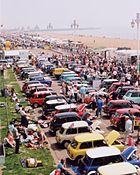
Each May the city hosts the Brighton Festival, the second largest arts festival in the UK ( Edinburgh). This includes processions such as the Children's Parade, outdoor spectaculars often involving pyrotechnics, and theatre, music and visual arts in venues throughout the city, some brought into this use exclusively for the festival. The earliest feature of the festival, the Artists' Open Houses, are homes of artists and craftspeople opened to the public as galleries, and usually selling the work of the occupants. Since 2002, these have been organized independently of the official Festival and Fringe.
Brighton Festival Fringe runs alongside Brighton Festival, and has grown to be the second largest fringe festival in the world. Together with the street performers from Brighton Festival's "Streets of Brighton" events, and the Royal Mile-esque outdoor performances that make up "Fringe City", outdoor spectacles and events more than double during May.
Other festivals include 'The Great Escape in May', featuring three nights of live music in venues across the city; the Soundwaves Festival in June, which shows classical music composed in the 21st Century, and involves both amateur and professional performers; Paddle Round The Pier; Brighton Live which each September stages a week of free gigs in pubs to show local bands; Burning the Clocks, a winter solstice celebration; and Brighton Pride (see lesbian, gay, bisexual and transgender community, below). The Kemptown area has its own small annual street festival, the Kemptown Carnival, and the Hanover area similarly has a "Hanover Day". Beachdown Festival, started in 2008 has recently ceased operations due to financial difficulties.
An inaugural White Nights ( Nuit Blanche) all-night arts festival took place in October 2008. 2009 saw the first Brighton Zine Fest celebrating zine and D.I.Y. culture within the city.
On 1 September 2007, competitors from the United Kingdom, United States, Germany and other countries convened for the World Beard and Moustache Championship. Hosted by The Handlebar Club, categories include Dali moustache, goatee and full beard freestyle. Additionally, Brighton is permanent home to notable moustache advocate Michael "Atters" Attree.
Brighton is the home of the UK's first Walk of Fame which celebrates the many rich and famous people associated with the city.
Museums
Brighton museums include Brighton Museum and Art Gallery, Booth Museum of Natural History, Brighton Toy and Model Museum, and Brighton Fishing Museum the long established social epicentre of the seafront, which includes artefacts from the West Pier. The Royal Pavilion is also open to the public, serving as a museum to the British Regency.
Theatre and cinema
Theatres include the Brighton Dome, the expanded Komedia (also used as a music venue) and the Theatre Royal which celebrated its 200th anniversary in 2007. There are also smaller theatres such as the Marlborough Theatre and Nightingale Theatre, both above pubs, which attract mostly local productions.
Brighton also has a history of involvement with the film industry, and the Duke of York's Picture House on Preston Circus has been in operation since 22 September 1910. There are multiplex cinemas at West Street and the marina.
Lesbian, gay, bisexual and transgender community
Brighton is well-known for having a substantial LGBT community, served by shops, bars and night-clubs in addition to support organisations. It is often referred to as "the gay capital of Britain". The Gay Pride carnival every August attracts thousands. It consists of a carnival parade and a party and funfair in Preston Park.
Economy
Brighton has a high density of businesses involved in media, particularly digital or "new media", and since the 1990s has been referred to as "Silicon Beach". According to the Boho Britain creativity index developed by United States economic regeneration expert Richard Florida, Brighton and Hove ranked sixth of 66 British new cities when measured against the three criteria of his index. Florida states the index measures the appeal of cities to the new " creative class" and is an indicator of a city's health.
American Express has plans to build a new headquarters building on John Street, behind its current headquarters in Edward Street. It employs around 3000, the largest private employer in the city.
" The Lanes" form a retail, leisure and residential area near the seafront, characterised by narrow alleyways following the street pattern of the original fishing village. The Lanes contain predominantly clothing stores, jewellers, antique shops, restaurants and pubs. The North Laine area is a retail, leisure and residential area immediately north of The Lanes. Its name derives from the Anglo-Saxon "Laine" meaning "fields". The North Laine contains a mix of businesses dominated by cafés, independent and avant-garde shops, bars and theatres.
Churchill Square is a shopping centre with a floor space of 470,000 sq ft (43,663 m2) and over 80 shops, several restaurants and 1,600 car-parking spaces. It was built in the 1960s as an open-air, multi-level pedestrianised shopping centre, but was rebuilt and enlarged in 1998 and is no longer open-air. Further retail areas include Western Road and London Road.
Education
Brighton & Hove City Council is responsible for 80 schools, of which 54 are in Brighton.
The University of Sussex established in 1961 is a campus university between Stanmer Park and Falmer, four miles (6 km) from the city centre. Served by frequent trains (to Falmer railway station) and 24-hour buses, it has a student population of 10,563 of which 70% are undergraduates.
The University of Brighton, the former Brighton Polytechnic, has a student population of 20,017 of which 80% are undergraduates. The University is on several sites with additional buildings in Falmer, Moulsecoomb, Eastbourne and Hastings.
In 2003, the universities of Sussex and Brighton formed a medical school, known as Brighton and Sussex Medical School. The school was one of four new medical schools to be created as part of a government programme to increase the number of qualified NHS doctors. The school is also based in Falmer and works closely with the Brighton and Sussex University Hospitals NHS Trust
A range of non-university courses for students over 16, mainly in vocational education subjects, is provided at the further education college, City College Brighton and Hove. More academic subjects can be studied for 16–18 year-olds at Brighton Hove & Sussex Sixth Form College (BHASVIC) in the Seven Dials area. Varndean College in North Brighton occupies a commanding position. The 1920s building is celebrated for its façade and internal quads. The college offers academic A levels, The International Baccalaureate and vocational courses.
There are state schools and some faith schools. Notable state schools include Longhill High School, Varndean School, Patcham High School, Dorothy Stringer High School, Blatchington Mill School and Sixth Form College, Hove Park School and Sixth Form Centre, Brighton Aldridge Community Academy and Cardinal Newman School (a large Roman Catholic secondary school, which also caters for the children of the large Coptic Orthodox community).
There are also a number of private schools, including Brighton College, Roedean School, Steiner School, BHHS and a Montessori School. As with the state schools, some independents are faith-based; Torah Academy, the last Jewish primary school, became a Pre-K/Nursery School at the end of the 2007.
In spring and summer, thousands of students from all over Europe gather to attend language courses at the many language schools.
Politics
Brighton and Hove is part of three constituencies in the British Parliament: Brighton Kemptown, Brighton Pavilion, and Hove. These three seats are all marginal constituencies. They were held by Labour from 1997 to 2010. At the 2010 British election, Brighton Kempton and Hove both elected Conservative MPs, Simon Kirby and Mike Weatherley respectively, while Brighton Pavilion elected Caroline Lucas, the first Green MP ever elected to Westminster. Lucas won 16,238 votes (31.3%), compared with Labour's 14,986 votes (28.9%) and the Conservative's 12,275 votes (23.7%). In European elections, Brighton is part of the European Parliament constituency of South-East England. Caroline Lucas has been a Member of the European Parliament for the South East Region since 1999.
The political campaigning group Justice? and its SchNEWS newspaper are based in Brighton, at the Cowley Club libertarian social centre; also operating from the town is the Brighton and Hove Palestine Solidarity Campaign. The presence of a British subsidiary of the United States arms company EDO Corporation in Moulsecoomb, Brighton, has been the cause of protests since 2004.
Brighton's citizens have developed a reputation in recent years for their readiness to challenge the views of the council's planning department. One of the main campaigning organisations is savebrighton, founded in 2007 to oppose the overdevelopment of Brighton Marina. Savebrighton has also been active in opposing other planning applications for developments it has regarded as excessive, out of context or otherwise inappropriate.
Sport
Brighton and Hove is home to the Sussex County Cricket Club based on Eaton Road in Hove. Brighton is also the home of Brighton & Hove Albion Football Club, who played at the Goldstone Ground for 95 years until they were forced to sell it in 1997 to pay off debts. The club spent two years ground-sharing at Gillingham before returning to the town as tenants of the Withdean Athletics Stadium. However, the club is due to move to a permanent home at Falmer at the start of the 2011/12 season. The new stadium, the Falmer Stadium, is currently under construction by The Buckingham Group, who built the MK Dons stadium. The club's notable achievements including winning promotion to the Football League First Division for the first time in 1979, staying there for four seasons, during the last of which they reached the FA Cup final and took Manchester United to a replay before losing 4–0. Notable former managers of the club include Brian Clough, Peter Taylor, Jimmy Melia, Liam Brady, Jimmy Case, Steve Gritt, Brian Horton, Steve Coppell and Mark McGhee. Notable former players include Gareth Barry, Dave Beasant, Justin Fashanu, Dennis Mortimer, Gordon Smith, Frank Stapleton, Howard Wilkinson and Bobby Zamora.
Brighton hosts what is commonly held to be the world's oldest motor race, the Brighton Speed Trials which has been running since 1905 on Madeira Drive (the road being originally constructed for this purpose). The event is organised by the Brighton and Hove Motor Club and normally takes place on the second Saturday in September.
There is also an annual beach soccer competition in a temporary stadium on imported sand on the beach. The inaugural contest in June 2002 featured football stars such as Eric Cantona and Matt Le Tissier.
Brighton has a horse-racing course, Brighton Racecourse, with the unusual feature that when the full length of the course is to be used, some of the grass turf of the track has to be laid over the tar at the top of Wilson Avenue, a public road, which therefore has to be closed for the races.
There is a greyhound racing circuit in Hove, run by Coral, at which Motorcycle speedway racing was staged in 1928.
Brighton is home to Brighton Football Club (RFU) which is one of the oldest Rugby Clubs in England.
Basketball team Brighton Bears were in the British Basketball League before dropping out at the end of the 2005/06 season.
Brighton Ultimate, an ultimate Frisbee team was set up in 1985.
Brighton Tsunami American Football Club was started in 2000 for students of the University of Brighton. It plays at the university's Falmer site, between November and March.
The Brighton and Hove Petanque Club runs an annual triples, doubles and singles competition, informal KOs, winter and summer league, plus Open competitions with other clubs. The club is affiliated to Sussex Pétanque, the local region of the English Pétanque Association, so they can also play at a Regional and National level. The Peace Statue terrain is the official pétanque terrain situated on the seafront near the West Pier.
There are yachting clubs and other boating activities run from Brighton Marina.
Brighton has two competitive swimming clubs. Brighton SC formed in 1860 claims to be the oldest swimming club in England. Brighton Dolphin SC was formed in 1891 as Brighton Ladies Swimming Club and met at Brills Baths in Pool Valley.
Brighton is home to the headquarters of the Dragon Martial Arts Association and White Crane Martial Arts, martial arts organisations teaching traditional Tai Chi, Kung Fu and Chinese Kickboxing. Brighton Judo Club is located just opposite the European headquarters of American Express.
The inaugural Brighton Marathon took place on 18 April 2010. It started in Preston Park and finished after the participants had run from Rottingdean to Shoreham-by-Sea Shoreham and then back to Madeira Drive.
Brighton is also home to the Sussex Swans Australian Rules Football Club that play in the Southern League and won the Grand Final in 2010 beating the Bournemouth Demons at Hove Rugby Club. They are also current holders of the Titanic Cup, the league's pre-season tournament, and as such are considered the most successful team in the competition.
Transport
Public transport dates back to 1840. There are several railway stations, bus services, taxis, and coach services. A Rapid Transport System has been under consideration for some years and in the past it has had trolleybuses, ferries, trams and hydrofoil services.
Frequent trains operate from Brighton Station. Many Brighton residents commute to work in London and destinations include London Victoria, London Bridge, and Gatwick Airport, with trains continuing to Bedford. The fastest service from London Victoria takes 51 minutes. Lines west and east from Brighton serve stations to Worthing, Portsmouth and Southampton in the west and via Lewes to Newhaven, Eastbourne, Hastings and Ashford, Kent in the east. A wider range of long-distance destinations was served until 2007–08 when rationalization caused the ending of services via Kensington Olympia and Reading and beyond to Milton Keynes, Birmingham and Manchester. Twice-daily services remain, however, on the line west to Bristol.
Brighton & Hove Bus and Coach Company operates 300 buses. There is also a limited night service. Brighton Buses are often named after famous local figures. Brighton also has buses that run on recycled bio-fuel, obtained from locally-sourced used cooking oil, The Big Lemon run from university of sussex into the centre of Brighton. Brighton seafront is the home of Volk's Electric Railway, the world's oldest electric railway.
Nearest places
- Hove
- Portslade
- Patcham
- Withdean
- Hollingbury
- Bevendean
- Lewes
- Falmer
- Moulsecoomb
- Whitehawk
- Pyecombe
- Hurstpierpoint
- Ditchling
- Hassocks
- Burgess Hill
- Rottingdean
- Saltdean
- Peacehaven
- Shoreham-by-Sea
- Lancing
- Worthing
